Sautéed Taiwanese Cabbage Recipe
If you haven’t tried my Taiwanese cabbage stir fry, you are missing out! Taiwan cabbage is naturally sweet, crisp, and juicy. Only 4 ingredients are needed – Taiwan flat cabbage, shiitake mushroom powder (or salt), oil, and stock.
I’ll show you where to buy Taiwanese cabbage, how to cut it, and the best way to cook it. Get ready for tons of flavor in under 15 minutes!
If you love Asian cabbage as much as I do, add my Chinese cabbage stir-fry and Asian chicken cabbage salad recipes to your must-make list, too!
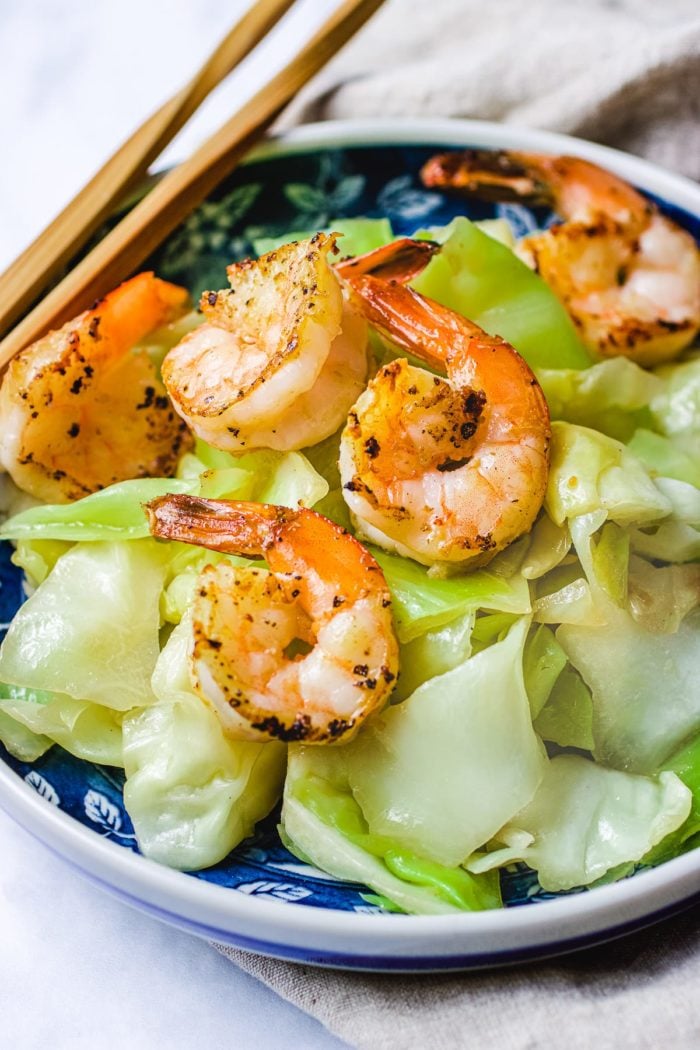
What is Taiwan cabbage
Taiwanese cabbage, also called flat cabbage or Taiwan cabbage, is a variety of Chinese cabbage commonly used in Taiwanese, Japanese, and Korean cuisine. it’s called 高麗菜 (Gāolí cài) in Taiwan. It has broad, pale green leaves with white ribs and a mild flavor.
Unlike tighter-headed green cabbages, Taiwanese cabbage leaves are loose and open. It has a soft, tender texture and contains vitamins C and K, calcium, and fiber.
Taiwanese cabbage can be used in a variety of dishes. It can be eaten raw in salads, cooked briefly in stir-fries, add to Jiaozi dumplings, or added to soups and stews to retain its signature crunchiness and sweet flavor. You can find them in local Chinese, Korean, or Japanese grocery stores.

Here are some examples of how Taiwanese cabbage is used in Asian cuisine:
- Stir fry: Taiwanese cabbage is perfect for quick stir fries. All you need are salt, oil, and minced garlic to make a quick sauteed cabbage.
- Soup/stew: You can also braise it, add it to soup, or vegan hot pot.
- Kimchi: Taiwanese cabbage is a common ingredient in kimchi, a traditional Korean fermented cabbage dish.
- Japchae: Japchae (Korean stir-fried sweet potato noodles) is a stir-fried noodle dish that often includes Taiwanese cabbage.
- Bibimbap: Bibimbap is a rice bowl dish that often includes Taiwanese cabbage, as well as other vegetables and meat. See my vegetarian bibimbap.
- Sukiyaki: Sukiyaki is a Japanese hot pot dish that often includes Taiwan cabbage.
Ingredients
All you need are 4 ingredients to make this Taiwanese cabbage recipe, and chances are you might already have them in your pantry!

- Taiwanese cabbage: a variety of loose-leafed Chinese cabbage with broad, pale green leaves, mild flavor, and crunchy texture, is nutrient-rich. It should have a smooth exterior with no bruises and feel heavy in your hands.
- Cooking oil: Select a neutral flavored oil so it doesn’t overpower the sweet flavor of the Taiwanese flat cabbage. I recommend using avocado oil.
- Shiitake mushroom powder seasoning (or coarse salt): Not all mushroom seasonings taste the same. I recommend using shiitake mushroom seasoning from Asia. It’s a good substitute for MSG and adds depth and umami flavor to the dish. I use Takii’s brand (link in the recipe).
- Stock (or Chinese cooking wine): In Taiwanese cooking, a small amount of Chinese cooking wine or Taiwanese michu is used to deglaze the dish. The alcohol evaporates under high heat and leaves a distinct aroma that makes the dish taste authentic. You can also use chicken or vegetable stock for alcohol-free or use Japanese mirin. See my Chinese pantry staples for more gluten-free choices.
What not to use: I do not recommend adding rice vinegar to this dish as it’s not a typical Taiwanese flavor. Stir fried Chinese cabbage is a more suitable dish to add a small amount of it.
Substitutions and variations
- Cabbage: If you can’t find Taiwanese cabbage, here are some substitutes: Use savoy or green cabbage sliced into thin, bite-sized pieces. These cabbages contain less water. Adjust the cooking time and use a little more stock to deglaze the stir fry.
- Aromatics: If you love garlicky Din Tai Fung Taiwanese cabbage recipe, thin slice a few garlic cloves and toss them into the stir fries. Take care not to burn the garlic.
- Garnish: Keep the garnish simple. Add a few drizzles of toasted sesame oil if you prefer.
- Add sauce: You can also add a small tablespoon of light soy sauce, vegetarian oyster sauce, Taiwanese shacha sauce, or a teaspoon of garlic chili sauce to the stir fry to create more flavor variety.
- Add proteins: In the photos, the cabbage stir-fry is shown accompanied by seared shrimp. However, the shrimp is completely optional. Feel free to substitute grilled chicken, pork, steak, fish, or other proteins if desired. The cabbage also makes a fantastic stand-alone side dish all on its own.
How to sautee Taiwan cabbage
For addictively crisp-tender Taiwan cabbage stir-fry, the key is proper skillet pre-heating before adding oil and vegetables. Definitely don’t boil Taiwanese cabbage – that will lead to a mushy, wilted texture. Here’s how:
- Trim the outer leaves and base of cabbage then halve, quarter, and slice lengthwise into 2-3 inch pieces. Cut core sections smaller.
- Rinse cabbage, drain well, and pat dry to prevent browning.
- Preheat a large skillet or wok over medium heat. When hot, add oil and swirl to coat.
- Add cabbage and turn the heat up to medium-high or high. Toss frequently for 3 minutes.
- Sprinkle in mushroom powder, and sauté 1 minute. Deglaze pan with stock, sauté 1 more minute until crisp-tender.
- Turn off the heat. Adjust seasoning. Serve cabbage warm or at room temperature.
If you are interested in learning more about properly preheating your skillet, see my article on how to make tender beef stir-fry. That post discusses the type of sauté pan to use and includes tips for testing the temperature to ensure your pan is preheated correctly before stir-frying.
How to cut Taiwan cabbage for stir fry
With its flatter shape, Taiwanese cabbage is easier to cut than round green cabbage. When stir-frying, dice the pale leaves into bite-sized pieces slightly larger than the stems so the leaves cook quickly while staying crunchy.
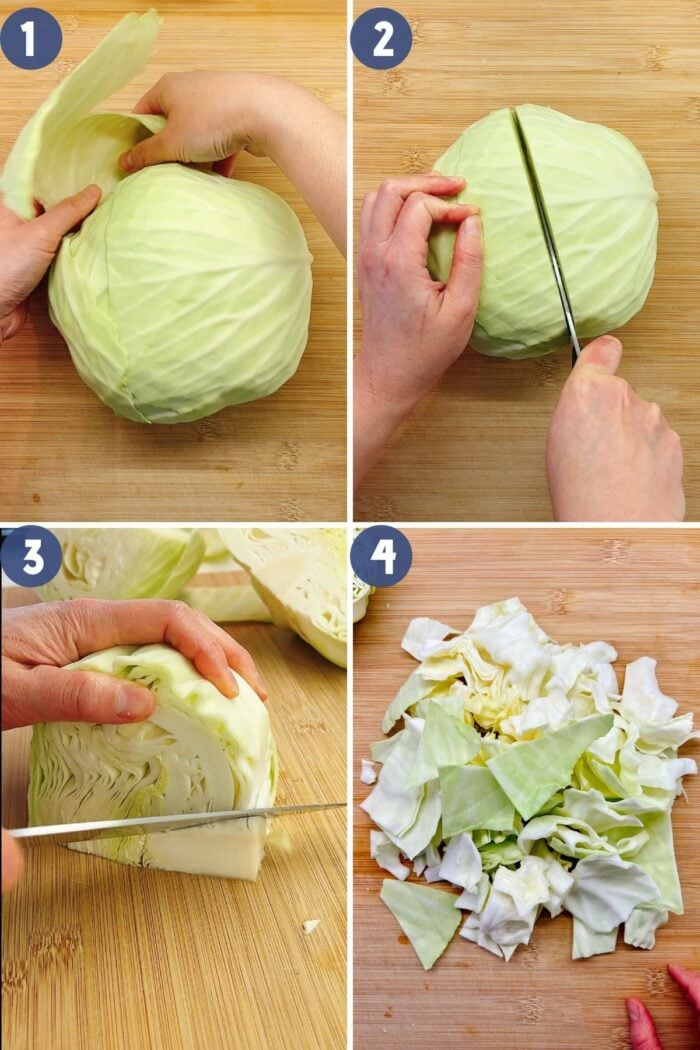
- Remove any damaged outer leaves and trim the base of the cabbage.
- Using the tip of a chef’s knife, slowly and carefully rock the blade to halve, then quarter the cabbage.
- Cut out the cores from the quartered cabbages at a 45-degree angle.
- Slice the cabbage quarters into 2-3 inch lengths for bite-sized pieces. For denser sections nearer the core, cut pieces slightly smaller so they cook evenly and quickly.
- Place the diced cabbage in a large bowl and rinse thoroughly. Drain well in a colander to remove excess moisture. You can also pat dry with a clean kitchen towel. Removing moisture prevents browning.
The chopped cabbage can be stored in an airtight container in the fridge for 2-3 days before using in stir-fries or recipes. Keep dry and only rinse the cabbage when ready to cook.
How to make ahead, store, and reheat
When it comes to simple stir-fried cabbage, planning ahead is usually not necessary. However, if you did want to prep it in advance, here are a few suggestions:
- Make-ahead: After chopping the cabbage, store it in an airtight container and refrigerate for up to 2-3 days before sautéing. Rinse just before cooking.
- Storage: Once sautéed, cabbage dishes are stored well in the refrigerator for 3-4 days in an airtight container. The texture may soften slightly.
- Reheat: Taiwanese cabbage contains a lot of natural juices, so it’s best not to add extra water when reheating. Instead, it can be served chilled straight from the fridge for a refreshing bite. If you want to serve it warm, lightly microwave the sautéed cabbage on medium power for 1 minute just until heated through. The natural sweetness and crunch will remain.
What to serve it with
Taiwanese cabbage stir-fry is extremely versatile – it can be enjoyed on its own or paired with a variety of other dishes. Here are some ideas:
- More Taiwan vegetable dishes: For a veggie-focused meal, you can serve the cabbage stir-fry with Snow peas stir fry, Chinese mustard green recipe, Chinese broccoli stir-fry with garlic sauce, Din tai fung green beans, or Chinese broccoli with oyster sauce.
- Pair with protein: To make it a heartier meal, the crisp cabbage also pairs wonderfully with Taiwanese popcorn chicken, salt and pepper tofu air fryer, or a comforting Instant Pot Taiwanese beef stew.
Umami tips
- Taiwanese cabbage (or flat cabbage) is a versatile Chinese cabbage with broad, pale leaves and a mild, slightly sweet flavor.
- It has a soft, tender yet crunchy texture perfect for stir-fries when handled properly.
- Cut the leaves into bite-sized pieces (about 2 inches wide) slightly larger than the stems for even cooking.
- Dry cabbage thoroughly after rinsing to prevent excess moisture from steaming the cabbage.
- Use a very hot wok or skillet and cook over high heat for just 2-3 mins, tossing frequently.
- Quick cooking retains the signature crunch and juiciness. Don’t overcook into mush.
- Sprinkle with a bit of mushroom powder and other seasonings to taste at the end.
- Taiwanese cabbage can be enjoyed as a simple side or paired with meats and veggies.
FAQs
Taiwan cabbage has a flatter, more open shape with broad, light green leaves and a crisp texture perfect for stir-fries. Regular round cabbage has a denser head and tighter leaves that are thicker and darker green. Taiwan cabbage is milder and sweeter with a softer crunch and more juice when quickly cooked.
No, Taiwanese cabbage is different from green cabbage. It has paler green, loose flat leaves, mildly sweet flavor, tender crunchy texture, and contains more natural juices. Green cabbage has darker thicker leaves, denser round heads, bolder taste, and needs longer cooking time. Both work for stir fry but are different types of cabbage.
Taiwanese cabbage is a variety of Chinese cabbage with characteristic pale green, loosely packed leaves that are flat and oval-shaped. It has a milder, slightly sweeter taste than napa or savoy cabbage and an appealing tender-crisp texture. Quick stir-frying keeps Taiwanese cabbage crunchy. It’s a popular staple vegetable for everyday Asian cooking.
Taiwanese cabbage is also referred to as Chinese flat cabbage, or in Mandarin “Gao Li Cai” 高麗菜. It has loose pale green leaves and a crisp texture that’s different from napa cabbage. Its flat shape and mild sweet taste make Taiwanese cabbage perfect for quick stir-frying in Taiwanese and Chinese cuisines.
More Taiwan cabbage recipes
I hope you will give this simple Taiwan sauteed cabbage a try and let me know what you think! If you are looking for more ways to enjoy Asian cabbage, give these recipes a try, too!
- Chicken napa cabbage stir fry
- Instant pot chicken napa cabbage soup (This is a Chinese braised cabbage dish, almost similar to napa cabbage stew)
- Napa cabbage casserole
- Stir fried napa cabbage
- Asian coleslaw
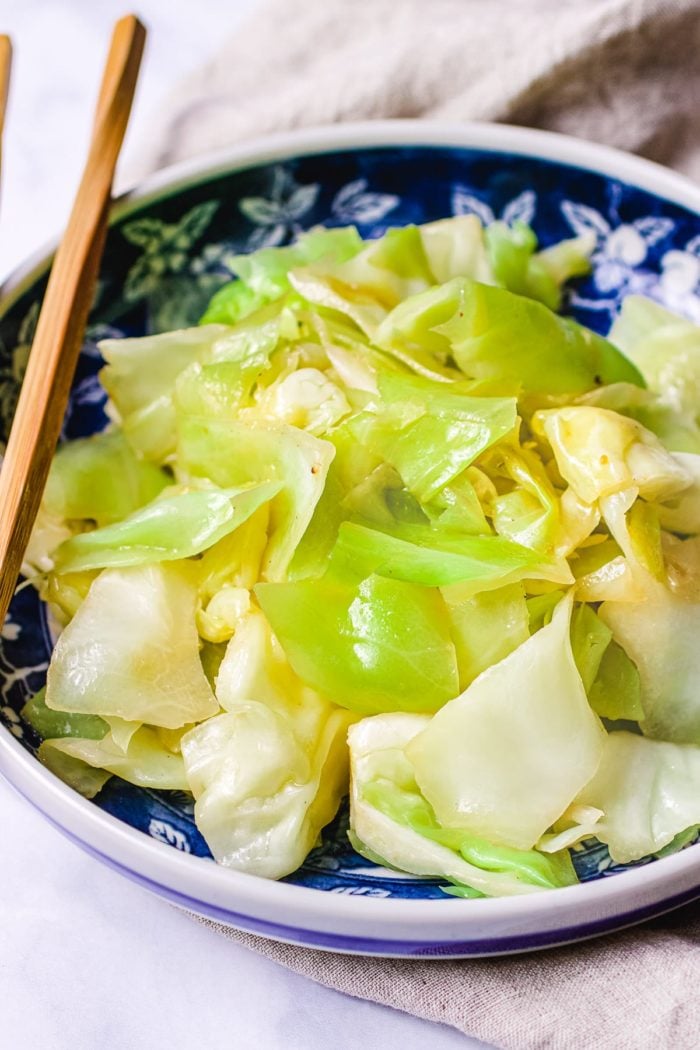
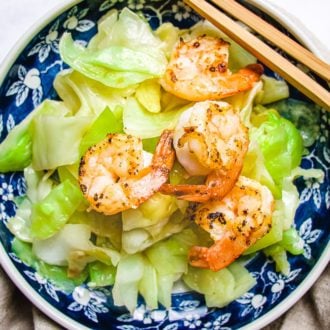
Taiwanese cabbage stir fry
Ingredients
- 1.5 lbs. Taiwanese Cabbage , also known as flat cabbage, Korean white cabbage
- 1.25-1.5 tsp Takii shiitake seasoning powder, or 1 tsp coarse salt to taste
- 2 tbsp avocado oil
- ½ -1 tbsp chicken or vegetable stock, or a splash of Chinese cooking wine/ Taiwanese michu
Instructions
- Start by removing any damaged outer leaves and trimming the base of the Taiwanese cabbage before carefully halving and quartering it lengthwise using the tip of a chef’s knife. Cut out the dense central cores at a 45-degree angle then slice the quarters into 2-3 inch lengths for bite-size pieces; dice any denser sections nearer the core slightly smaller.
- Rinse the chopped cabbage thoroughly, drain well in a colander, and pat dry to remove excess moisture which prevents browning.
- Preheat a 12-inch skillet or wok over medium heat. When the pan is hot enough that you can hold your palm about 2 inches above it, add oil and swirl to coat. If it starts smoking, it’s overheated – set aside to cool briefly before returning to the burner.
- Add the cabbage, be careful of the splatter, turn heat up to medium-high to high heat. Keep scooping and tossing frequently for about 3 minutes.
- Sprinkle in the mushroom powder and keep sauteing the cabbage for 1 minute. Deglaze the pan with stock (or cooking wine) and saute for 1 more minute. The cabbage should be tender yet crisp, and not too watery. Some parts will turn slightly translucent in pale yellow-green color.
- Turn off the heat. Taste and adjust with more shiitake mushroom powder or salt to taste. Serve warm or at room temperature over a large plate.
Notes
- If you can’t find Taiwanese cabbage, here are some substitutes: Use savoy or green cabbage sliced into thin, bite-sized pieces. These cabbages contain less water.
- In the photos, the cabbage stir-fry is shown accompanied by seared shrimp. However, the shrimp is completely optional. Feel free to substitute grilled chicken, pork, steak, fish, or other proteins if desired. The cabbage also makes a fantastic stand-alone side dish all on its own.
Nutrition
Made a dish and love it? Please remember to rate the recipe and leave a comment in the comment section below! It helps my blog grow organically so I can continue sharing free and awesome content with you. Thank you!




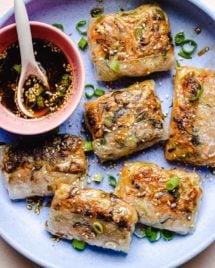
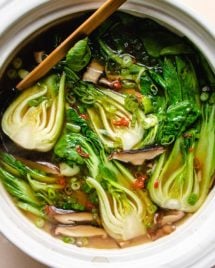


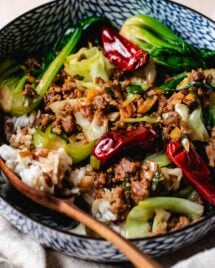
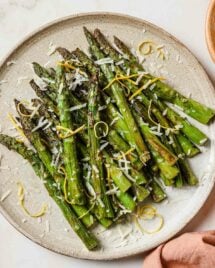
Made this today and we all loved it. It is also so healthy . I will add a little more of the Umami powder next time to add a little more flavour . Thank you ChihYu !
Thank you, Mimi! So glad you gave it a try!
Does the shiitake powder have a mushroomy flavour? We have family members that are not fond of mushrooms so would be good to know before ordering. Thank you
It’s made from shiitake mushrooms so I’d say yes 🙂
I was looking for a quick side dish to the steamed cod recipe and came across this sautéed cabbage recipe. So simple and delicious. I used the Trader Joe’s umami powder which I had on hand and it worked well. I love the consistency of the cabbage as it was warm but remained crispy. Also the tip about cutting the white parts of the cabbage smaller than the green parts was very helpful.
So happy to hear!
So many things you can do with the cabbage, this one was amazing. Your right It’s super tasty. Thanks for sharing!
Thank you so much!
That umami mushroom seasoning sounds very intriguing . .. I may have to order for this recipe and other stir frys. Thanks for the find
Never thought I’d fall in love with cabbage but I have. So good and so good for you.
My family loves cabbage this way. So simple, yet so delicious!
This sounds fabulous! i’m looking for clean eating recipes for the new year!
Seems so simple and looks SO good!
I enjoy cabbage and can’t wait to try this.
Thanks!
There are a few recipes in this post that will be on my menu next week!!!!
SO simple but delicious. That shiitake powder sound amazing!
So delicious, love cabbage, good to see it coupled with seafood, super tasty!
I’m always looking for a different side dish veggie to make– this is ideal!
Chihyu! We saw you used the shiitake seasoning while you were in Japan and immediately ordered a bag on amazon. We’ve been using it to season many simple stir-fry dishes and they all turned out GREAT! Just like you said, it works great with a quick cabbage stir-fry. So yummy! We used it to replace salt and it’s definitely an awesome seasoning to have at home. Thank you for sharing it with us! Love.
Thanks so much, Cynthia! So happy to hear.